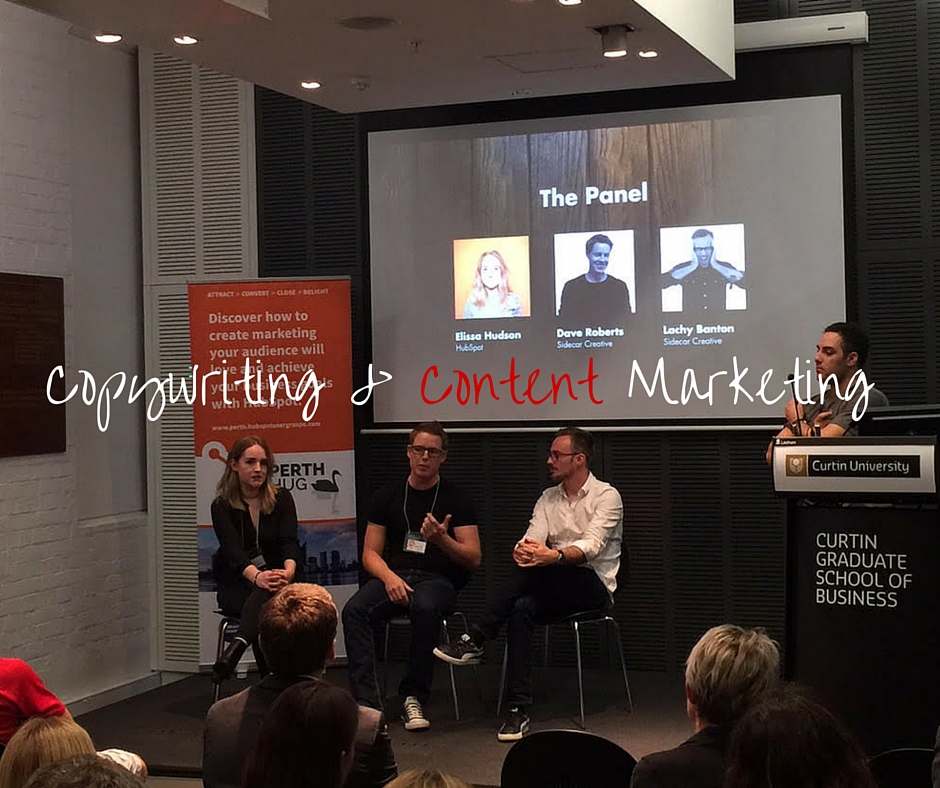
By Lachy Banton on Friday, May 27th, 2016 in Uncategorised.
There are 26 letters in the alphabet. But when you arrange those letters in a particular way, you can make people’s ears prick up and pupils dilate. One such arrangement is the word ‘content’ – it’s a hot topic for any business that’s serious about providing value to their customers and engaging new ones.
The only problem is, there’s a huge gap between knowing how important producing this content is, and actually producing it.
Dave and I saw just how wide this gap was at a recent (depending on when you read this) Hubspot User Group Perth event. We’d been approached by The Brand Manager – a HubSpot Platinum Certified Agency Partner – and asked if we’d like to participate in their event as part of the content marketing panel.
Naturally, we said yes.
The guys at The Brand Manager already had a Content & Campaign Marketing expert by the name of Elissa Hudson who could walk people through the strategy behind creating the content, but they needed someone who could bridge the gap between strategy and creation.
Once the panel kicked off, the questions came in thick and fast.
1) When writing a blog, should you write as ‘the company’ or as yourself?
Personally, I always write as myself. The reason is simple: a business has no brain and no hands so it can’t write a blog. A human will be writing your blog and a human will be reading it – ergo: people connect with people, not companies.
2) Is it important to write in your own voice? Why?
Yes! By writing in your own voice, you’re creating intimacy with the reader. Unlike a corporate writing style (which has its place), a conversational tone builds trust, and when someone trusts you they’re more inclined to form an emotional connection. If you wouldn’t say it to a friend, don’t write it.
3) What’s the difference between using passive or active language?
In sentence written in the active voice, the subject of sentence performs the action. In a sentence written in the passive voice, the subject receives the action. Make your copy more powerful by eliminating weasel words like may, maybe, hope, wish, try, but, could, perhaps and strive.
4) What does scanability mean and why is it important?
See how I’ve numbered and bolded subheadings, and broken up my paragraphs into varying lengths? This makes it easier for you to skim read and find the information that matters to you. Online, browsers rarely read web pages word for word – they’re more likely to scan the page for keywords. To help them find what they’re looking for, and fast, use typefaces, spacing, white space, layout, headings, formatting, bulleted lists, hyperlinks, graphics and images.
There you have it!
Now I know you’re probably thinking “I’m no good at writing” or “I just don’t have the time”… and that’s simply not true. I’m positive you can find 20 minutes every morning to put together a couple of posts or work on a weekly blog article. Sure, your writing might not be professional copywriter level – but it doesn’t always have to be.
Start by writing what you want to say and don’t worry about how you say it. The key is making a start. You can always edit and refine later.
Got a question about writing copy for content marketing? I’d love to hear it, so drop me a line on LinkedIn or fill out the contact form.
– Lachy Banton
